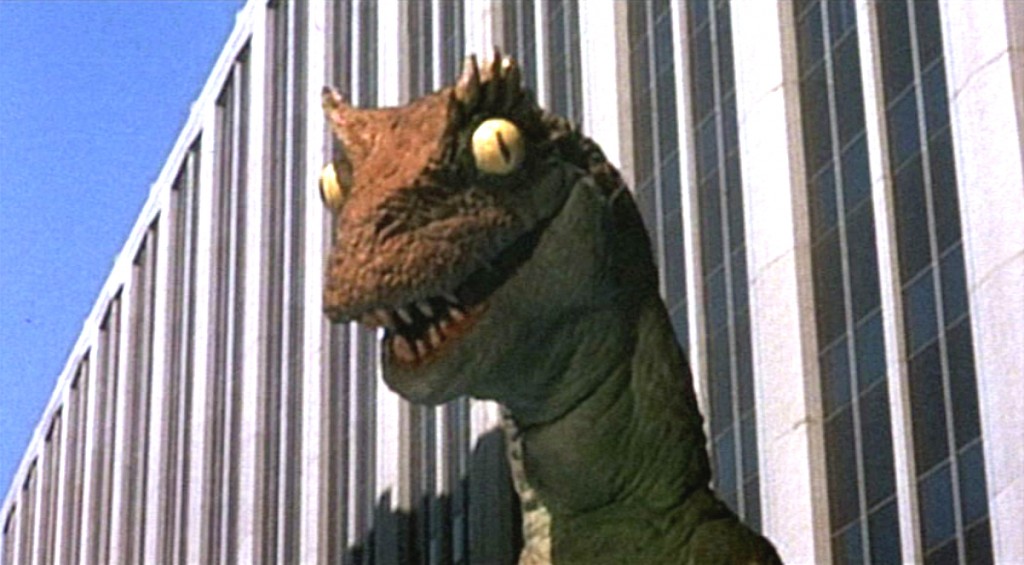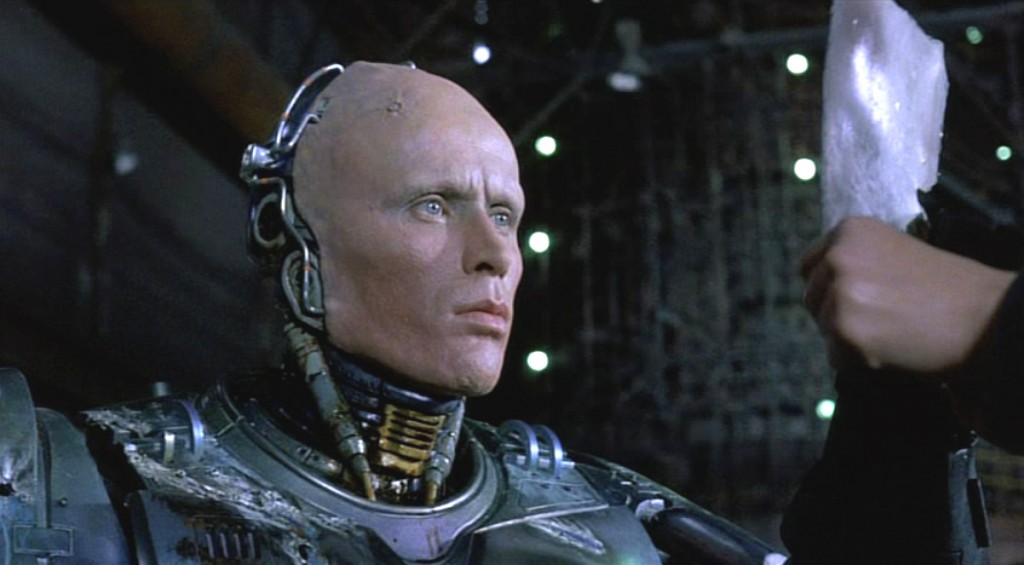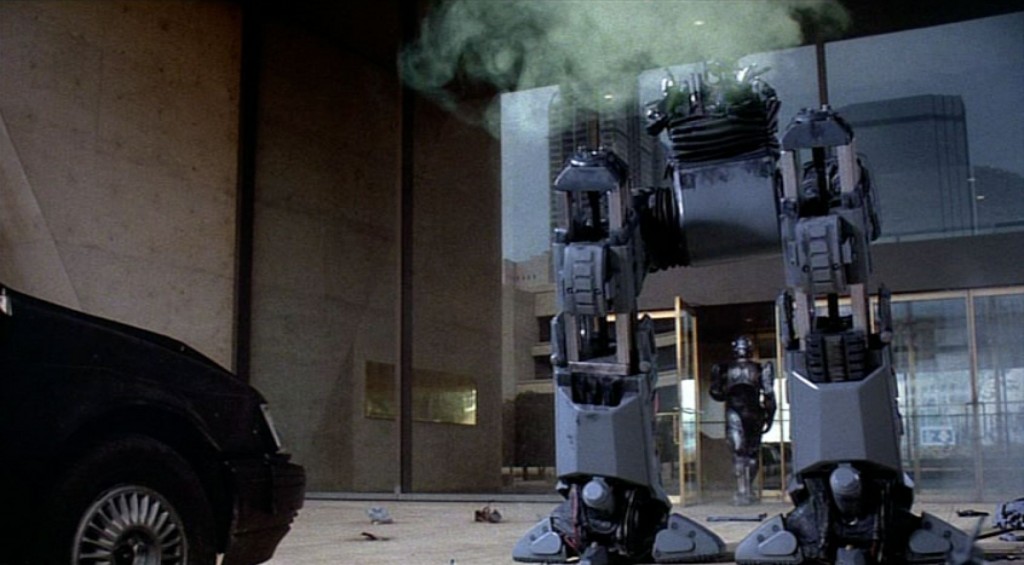Favorite screenplays: Robocop part 5
It warms my analytic heart when filmmakers announce act breaks with devices, and Robocop does not disappoint. Each act begins with a news report and attendant commercials (as news is, lest we forget, just another form of entertainment in a corporate oligarchy). Act III begins with a commercial for a car, the 6000 SUX, done in the style of The Beast from 20,000 Fathoms, yet another low-budget film reference to let cinephiles know they’re dealing with a self-aware, intelligent satire. The dinosaur in the car commercial terrorizes the city streets until it’s dwarfed by the advertised car. The joke, of course, is not just that the car is huge, but that the huge car out-dinosaurs an actual dinosaur. (It’s also fueled by dead dinosaurs, if you want to take its dominance that far.)
The news report then catches us up on the latest: the police in Detroit are set to strike, and the 1987 version of Fox News sets out to gather “fair and balanced” reporting: they interview a homeowner, who is against the strike, and a plainly drugged-out homeless man, who supports it. To underline the point, the “responsible homeowner” has the white-bread name of “Peter Whitley,” while the “unemployed man” is the utterly un-American “Keva Rosenberg” (probably related to those rotten Jews who sold atomic secrets to the Russkies). The joke, oddly, is on the viewer, since the homeowner is the one begging for the government handout of police protection while the bum is the one espousing personal responsibility.
Up in the OCP Tower, Boddicker comes to see Jones. Jones is livid at Boddicker for confessing Jones’s involvement (although not so concerned that he doesn’t hesitate to invite Boddicker up to his office and even tells his secretary to schedule the appointment, so there’s an official record of his confabbing with a known felon and crime kingpin). He orders Boddicker to kill Robocop, in exchange for being made head of the Delta City underworld (presumably bankrolled, protected and armed by Jones).
Robocop, meanwhile, heads back to the abandoned steel mill, the place of his death, to be reborn as Murphy. Common sense would dictate that traveling to your antagonist’s hideout is a bad place for some peace and quiet, but it serves a symbolic function: not only is Murphy “returning to the scene of the crime,” as it were, but he’s in little danger of meeting Boddicker there: the super-cop is now the hunted fugitive, the crime boss now has meetings in penthouse offices.
Lewis updates Murphy on the loss of his family: his wife took his son and moved far away, started over. Murphy sadly admits that he doesn’t remember them. It’s important that they be removed from the story, or else the very next thing Murphy would want to do is find them again. If they are eliminated, his goal becomes much clearer: to face down Boddicker and Dick Jones.
Night falls on Old Detroit, and, with the police on strike, the populace runs rampant, looting and pillaging. We find Emile sitting on the curb watching the omnipresent bawdy sitcom in a TV-store window. In one of the script’s most telling moments, Emile throws his bottle of whiskey through the store’s plate-glass window, not to steal the TV but to turn up the volume of the set against the noise of the surrounding riot. Looting and pillaging is old hat to Emile, the streets are his living room, and the rioters are interrupting his bourgeois entertainment. Boddicker and the rest of the gang pull up, all free from prison. Boddicker has some assault cannons he’s gotten from Jones. Their childlike glee as they destroy a city block for target practice before heading off to kill Murphy stands in stark contrast to Murphy’s predicament: he’s somber and shaken as he struggles to learn how to aim his own gun, now that his electronics has failed. Technology, in this instance, favors the wicked. He needs the assistance of Lewis, who represents a tender reminder of the man he was before his transformation, to re-learn how to shoot. It’s also telling that Murphy’s chosen target is jars of baby food: he’s not going to swallow the pablum of the corporate overlords any longer.
Nor, it seems, does he consider himself a “good cop” any longer, and says as much to Boddicker before he kills him. He never gets the chance to become a full-on vengeful murderer, the script makes sure that all his killings are in self-defense, but it does dangle the possibility of Murphy becoming, say, Clint Eastwood, and losing the soul he so desperately needs to regain.
Still, there are advantages to becoming a product. Lewis is mortally wounded in the battle with Boddicker, and Murphy wearily reminds her “They’ll fix you, they fix everything.” “Fixing everything” is, of course, a double-edged sword: corporate overlords can make everything shiny and new (like Delta City) and also make sure that every event breaks their way (like Delta City). That’s the beauty of vertical integration, and I’m reminded of Catch-22‘s Milo Minderbinder, who knew that it was no trick to buy eggs for five cents and sell them for three cents if you own both the egg producers and the egg buyers.
Meanwhile, back at OCP HQ, Jones has leaped into action, telling The Old Man and his board members that, due to the police strike, he can have ED-209s in place all over the city by the end of the week. That seems to be a drastically short schedule for a machine that’s still in prototype, but it’s the future, so okay. What’s more frustrating to me is that Jones didn’t have anything to do with the police strike (apart from helping to create the conditions that led to it), it’s mere coincidence that he’s benefitting from it now.
Murphy arrives at OCP HQ and, in the movie’s second-best joke, easily dispatches the ED-209 left to guard the entrance by using one of the assault cannons Jones gave to Boddicker, leaving only its legs waddling helpless around the plaza. That reflects, of course, the first rule of guerilla warfare: steal from your enemies and they become your suppliers. (The ED-209 isn’t just a great symbol of mass-produced mediocrity, it’s one of the funniest comic villains in movie history and a textbook example of stop-motion comedy.)
Murphy goes up to the OCP board room and accuses Dick Jones of murder. He uses the blood-drenched spike of his data-entry port (great piece of production design) to play the recording of Jones bragging about Morton’s murder. Jones’s final moments, where he takes The Old Man hostage at gunpoint to cover his getaway, prove to be too much corporate overreach for The Old Man. He fires Jones, allowing Murphy to shoot him so much he flies through a plate glass window and plunges to his death. Again, it’s important that Jones has a gun in his hand, otherwise Murphy is only a murderer. It’s also important that he goes out the window, so we don’t really know that it was Murphy’s shots that would kill him. (That, and nobody wants to see Jones possibly re-born as Robojones.) All that is important to justify the next bit of action, which is Murphy twirling his gun, T.J. Lazer style, before holstering it. He’s kept his promise to his now-forgotten son: he’s a good cop.
Finally, The Old Man, the man who rules Detroit, the founder of Delta City, the man connected to “the old ways,” when corporate heads were greedy and selfish but at least still made things that gave people jobs and built communities, asks the unmasked man “What’s your name?” Murphy, plain old Murphy, the most common name in Ireland, which would make it the most common name in white working-class America, is the answer. Murphy’s reward for settling the balance of his debt is, essentially, that the simple man, the “good cop,” gets a nod of respect from the king before he walks off into the sunset.
(Odd that “Jones,” an even more common name, is made the evil corporate head. “Jones” is a Welsh name, as is “Cox,” as in Ronny Cox, who plays Jones, but more important, it’s a Protestant name, whereas “Murphy” is distinctly Catholic [“Weller,” as in Peter Weller, who plays Murphy, is an English name]. A Jones could claim to have had relatives on the Mayflower, a Murphy, never. For what it’s worth, “Morton” is Scottish, quite a leap for Puerto-Rican-American Miguel Ferrer.)



I had completely forgotten about the stop motion dinosaur clip. I wonder if that was something in the original script, or made it into the movie more by happenstance: “Hey Paul Verhoeven, the guys who are animating the ED-209 have this Claymation dinosaur they’ve been using just for fun!” “Great – let’s make room for it!”
It would surprise me if it specified in the original script “Cheesy claymation dinosaur.”
In the version of the script I have, this media break consists of a news story about Sylvester Stallone dying in an attempt to be cloned, an animated dog food commercial (in which a boy dog chooses his dog food over humping a girl dog — “Everything your dog needs in just one can!”), and then goes into the strike story. And Keva Rosenberg was originally a (hippie) shopkeeper.
The final screen choices were the correct ones.
I didn’t even know the script indicated news breaks, part of me thought maybe there was another fifteen pages of drama in there that got cut out and the news breaks put in to cover the exposition.